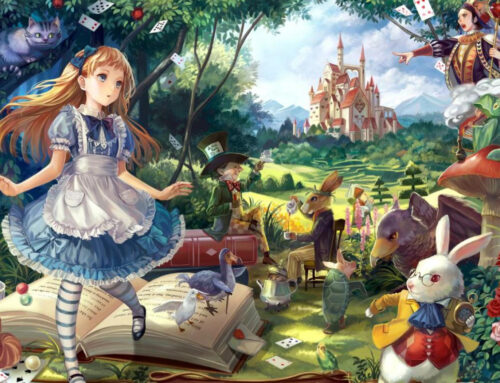The short story “The Djinn in the Nightingale’s Eye” which was written by A. S. Byatt, served as the inspiration for the film, Three Thousand Years of Longing. Idris Elba plays a djinn in the film who is freed from a bottle by a professor (Tilda Swinton) and tells tales from his countless years of existence.

Watch the trailer here:
The stories
A lesson about the power of wishing may be learnt from each of the five primary stories told in the film.
Please note that the below stories contain spoilers.
Story 1: The Queen of Sheba
The Djinn recounts the tale of King Solomon courting his cousin and lover, the Queen of Sheba. Solomon imprisons the Djinn in a bottle, tosses it out the window, and waits for a bird to cast it into the Red Sea, allowing him to keep Sheba for himself.
Story 2: Gülten
Gülten, a young concubine in Suleiman the Magnificent’s harem, is the subject of the second story. Gülten discovers the Djinn’s bottle and wishes for Suleiman’s son Mustafa to fall in love with her and have a child with her. Suleiman’s favourite concubine, Hürrem Sultan, plots to usurp the throne by convincing Suleiman that Mustafa will organize a coup and is incapable of leading the country. Mustafa is killed as a result, and the pregnant Gülten is also executed on Suleiman’s orders before she can make her final wish.
Story 3: Sugar Lump
For more than a century, the Djinn wanders the palace while the bottle is hidden, rendering him invisible. Young princes Murad IV and Ibrahim also come close to discovering the bottle, but are prevented from doing so by their mother Kösem Sultan.
Years later, Murad IV goes to war, where he becomes into a cruel and brutal leader before passing away from alcoholism. Ibrahim becomes the new sultan, after developing a fetish for curvaceous concubines. His favourite concubine, Sugar Lump, unintentionally finds the Djin bottle, at which point the Djinn cries out for her to make a wish so that he could be set free. Sugar Lump views him as a prankster and wishes him to return to his bottle and be cast into the sea.
Story 4: Zefir
In the Djinn’s final story, he talks of Zefir, the young wife of a Turkish merchant, who receives the bottle after it is found in the mid-nineteenth century. Zefir first wishes for wisdom, which the Djin grants in the form of literature, and then she asks to see the world as Djin’’s do. The Djinn offers stay in his bottle whenever Zefir feels too crowded by him, but Zefir wishes to forget they ever met, leaving him trapped and unknown once again.
Story 5: Alithea
After hearing the Djinn’s final tale, Alithea becomes eager for a romantic relationship between herself and the Djinn. She wishes for her and the Djinn to fall in love. Making good on her first wish, Alithea invites the djinn to reside with her in London. However, because of the Djinn’s unique physiology, he is incompatible with the wavelengths of contemporary technology and finally starts to die until Alithea grants her final two wishes (for him to speak and lastly, to return to the place which he truly belongs) , which liberates him.
7 Fun facts about Three Thousand Years of Longing
(1) The fictional Shahrazad Airlines is mentioned multiple times in the movie. The name pays homage to the legendary storyteller Scheherazade from “1001 Arabian Nights,” who entertained her king with a fantastical tale every evening.

(2) A compilation of Middle Eastern folktales called 1001 Arabian Nights was written in Arabic during the Islamic Golden Age. Because of the earliest English-language edition’s (c. 1706–1721) rendering of the title as The Arabian Nights’ Entertainment, it is sometimes referred to in English as the Arabian Nights. The majority of the literature is written in prose.
(3) The Greek goddess of truth Aletheia inspired the name Alithea (also known in Roman mythology as Veritas).
(4) The Queen of Sheba’s leg hair is legendary. Her leg hair is mentioned in Jewish and Islamic tradition and books concerning her. “When he spotted the hair on her leg, King Solomon replied, ‘Your beauty is the beauty of women, but your hair is the hair of men. Hair is now lovely for a man but shameful for a lady.'” – From the Targum Sheni to Esther, c. 7th century. The Targum Sheni (“Second Targum”) is an Aramaic translation (targum) and elaboration of the Book of Esther that adds significant new apocryphal material to the Biblical account that is not immediately related to the Esther story.
(5) In Alithea’s storytelling lesson, a comic-book depiction of the Justice League can be seen. Director George Miller was slated to direct a Justice League picture for Warner Brothers in 2007, however the film was cancelled due to the 2007-2008 writer’s strike and difficulties finding filming locations.
(6) The film is an adaptation of the 1994 short story “The Djinn in the Nightingale’s Eye” by A. S. Byatt. The story tells the tale of middle-aged Gillian Perholt, a British narratologist, receives a gorgeous bottle while attending a convention in Turkey. The djinn she later frees not only grants her three wishes, but also instructs her on how to avoid the typical folk-tale irony in which the wisher lives to regret the fulfilment of his or her wants.
(7) “Cautionary Tale,” an original song performed by Matteo Bocelli, is included in the 9-track album. The emotionally charged track, written by Holkenborg in conjunction with George Miller and Augusta Gore, serves as the film’s end title theme.








